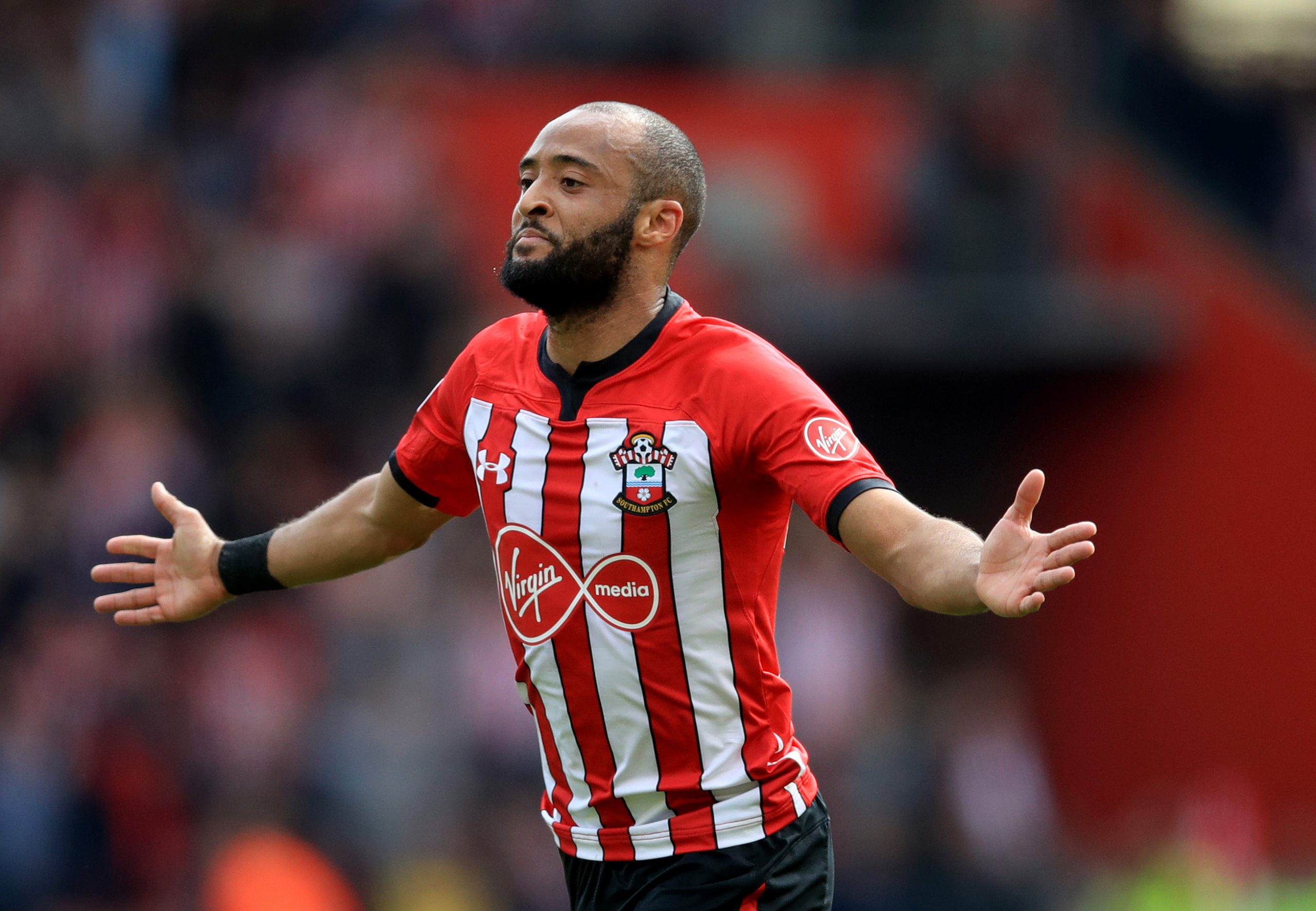After narrowly avoiding relegation in 2017-18, Southampton began last season in a manner that suggested they would again be involved in a scrap against the drop. Eight defeats and just one win across their first 15 matches left them down in the bottom three by early December. It was at that stage that they hit the reset button. Mark Hughes had somewhat questionably been handed a long-term deal after securing a sufficient but hardly impressive eight points in eight matches to keep them up the previous season, and his limitations swiftly became clear. He was replaced by the former RB Leipzig coach Ralph Hasenhüttl, who steered the club to an eventual 16th-place finish, five points clear of the drop zone. The stylistic impact of Hasenhüttl’s arrival was clear. Famed both at Leipzig and previously at Ingolstadt for an aggressive high press, his Southampton side were much more active all over the pitch than they had been under Hughes. They went from allowing 12.25 passes per defensive action (PPDA) prior to his arrival to just 9.82 thereafter. They also pushed their defensive line up, going from almost no defensive activity in opposition territory to completing a league average or above number of actions in various zones there. 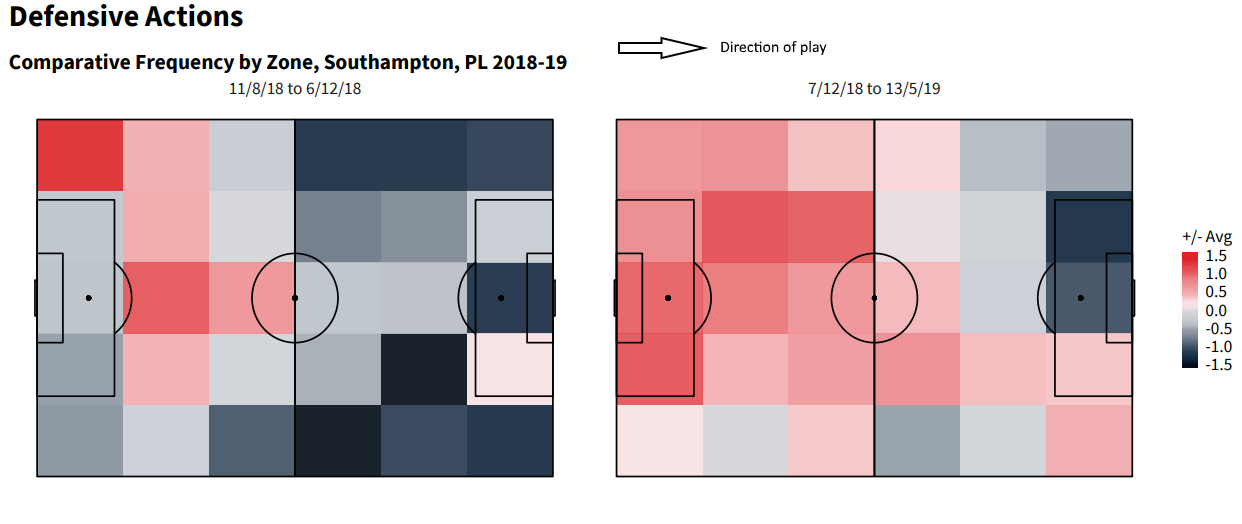 The change in approach did produce a defensive improvement. Southampton conceded 1.57 goals per match under Hasenhüttl compared to 1.93 previously, while their expected goals (xG) conceded per match fell from 1.48 down to 1.30 -- although it must be noted that over 40% of that was accounted for by an improvement in their defending of set pieces. But defending higher and more proactively didn’t do anything to enliven the team’s turgid attack.
The change in approach did produce a defensive improvement. Southampton conceded 1.57 goals per match under Hasenhüttl compared to 1.93 previously, while their expected goals (xG) conceded per match fell from 1.48 down to 1.30 -- although it must be noted that over 40% of that was accounted for by an improvement in their defending of set pieces. But defending higher and more proactively didn’t do anything to enliven the team’s turgid attack. 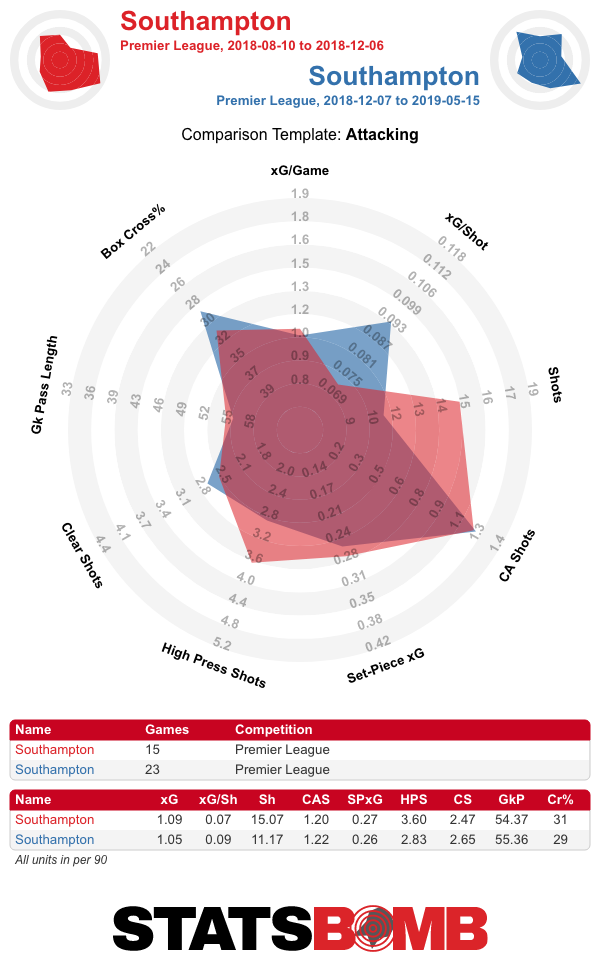 The overall result was that Southampton transitioned from a league-sixth-worst average xG difference (xGD) of -0.39 per match before Hasenhüttl to a league-seventh-worst -0.25xGD per match thereafter. It was enough of an improvement to see them fairly comfortably avoid relegation but still made it clear that greater strides would need to be taken to get back to the level of their four consecutive top-eight finishes between 2013 and 2017. Some of that is likely to come from simply having a preseason for Hasenhüttl to get his ideas across. As Grace astutely noted in her piece in April, Hasenhüttl’s first part-season in the Premier League had much in common with that of Jurgen Klopp’s at Liverpool. His side pressed a lot but did so a little haphazardly at times, lacking the clear organisational principles that a summer with the team will allow him to instill.
The overall result was that Southampton transitioned from a league-sixth-worst average xG difference (xGD) of -0.39 per match before Hasenhüttl to a league-seventh-worst -0.25xGD per match thereafter. It was enough of an improvement to see them fairly comfortably avoid relegation but still made it clear that greater strides would need to be taken to get back to the level of their four consecutive top-eight finishes between 2013 and 2017. Some of that is likely to come from simply having a preseason for Hasenhüttl to get his ideas across. As Grace astutely noted in her piece in April, Hasenhüttl’s first part-season in the Premier League had much in common with that of Jurgen Klopp’s at Liverpool. His side pressed a lot but did so a little haphazardly at times, lacking the clear organisational principles that a summer with the team will allow him to instill. 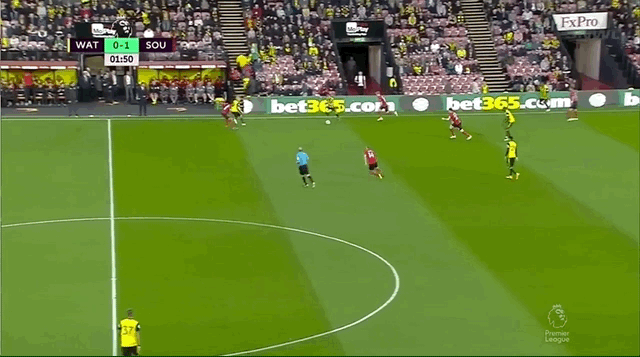 It is also worth noting that during the latter part of the season, Southampton’s attacking combination play and output began to show signs of improvement. Over one 10-match spell they averaged 1.34xG per match -- well above their average output. The one forward who undoubtedly benefited from Hasenhüttl’s appointment was Nathan Redmond. All of his six goals and four assists came following the Austrian’s arrival, and his overall statistical output also greatly improved. He even seemed to do a good job of handling the extra defensive work required of him. If maintained over an entire season, his xG contribution (xG + expected assists (xA)) of 0.39xG per 90 under Hasenhüttl would make him a top-50 Premier League attacker by that measure; if a further 0.10 could be squeezed out of him, he’d be in the top 25.
It is also worth noting that during the latter part of the season, Southampton’s attacking combination play and output began to show signs of improvement. Over one 10-match spell they averaged 1.34xG per match -- well above their average output. The one forward who undoubtedly benefited from Hasenhüttl’s appointment was Nathan Redmond. All of his six goals and four assists came following the Austrian’s arrival, and his overall statistical output also greatly improved. He even seemed to do a good job of handling the extra defensive work required of him. If maintained over an entire season, his xG contribution (xG + expected assists (xA)) of 0.39xG per 90 under Hasenhüttl would make him a top-50 Premier League attacker by that measure; if a further 0.10 could be squeezed out of him, he’d be in the top 25. 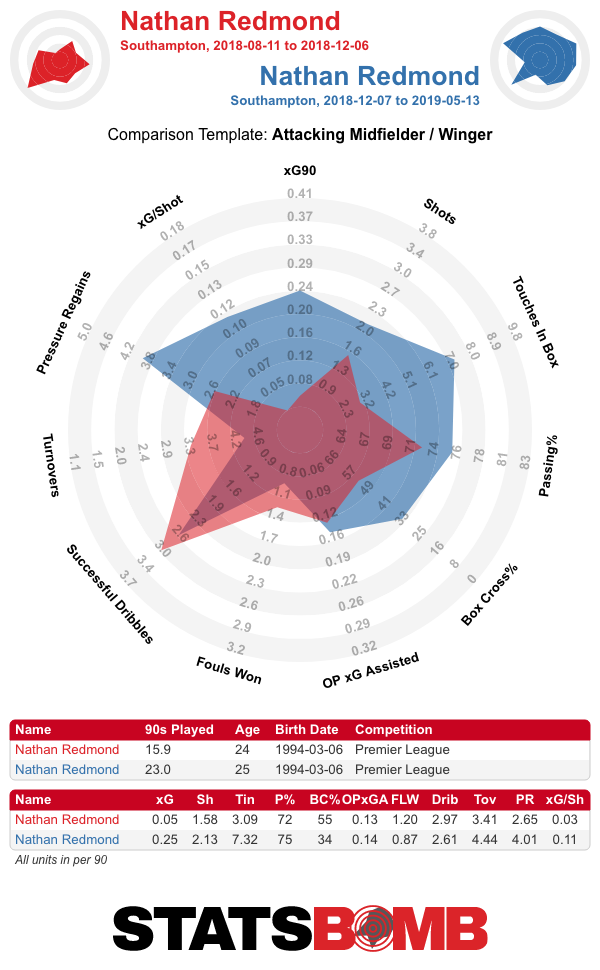 But it was clear that a better supporting cast would be required for Southampton to take a step forward in 2019-20. The last time a Saints player hit double figures in the league was back in 2015-16, when Sadio Mane, Graziano Pelle and Shane Long all reached that mark. Last season, James Ward-Prowse and Danny Ings were their joint top scorers with just seven goals apiece. Unsurprisingly, forwards have been the focus of their transfer work to date. Nearly £20 million was tied up in the permanent signing of Ings following his loan from Liverpool. He is a solid attacking contributor, a willing defensive runner, and although his injury history certainly raises some concerns, his fee was offset by the sales of two academy products in Matt Targett and Sam Gallagher. He is joined by two new arrivals: Che Adams and Moussa Djenepo. Southampton shelled out just north of £15 million to sign Adams after his 22 goals at an otherwise middle-of-the-road Birmingham team in the Championship last season.
But it was clear that a better supporting cast would be required for Southampton to take a step forward in 2019-20. The last time a Saints player hit double figures in the league was back in 2015-16, when Sadio Mane, Graziano Pelle and Shane Long all reached that mark. Last season, James Ward-Prowse and Danny Ings were their joint top scorers with just seven goals apiece. Unsurprisingly, forwards have been the focus of their transfer work to date. Nearly £20 million was tied up in the permanent signing of Ings following his loan from Liverpool. He is a solid attacking contributor, a willing defensive runner, and although his injury history certainly raises some concerns, his fee was offset by the sales of two academy products in Matt Targett and Sam Gallagher. He is joined by two new arrivals: Che Adams and Moussa Djenepo. Southampton shelled out just north of £15 million to sign Adams after his 22 goals at an otherwise middle-of-the-road Birmingham team in the Championship last season. 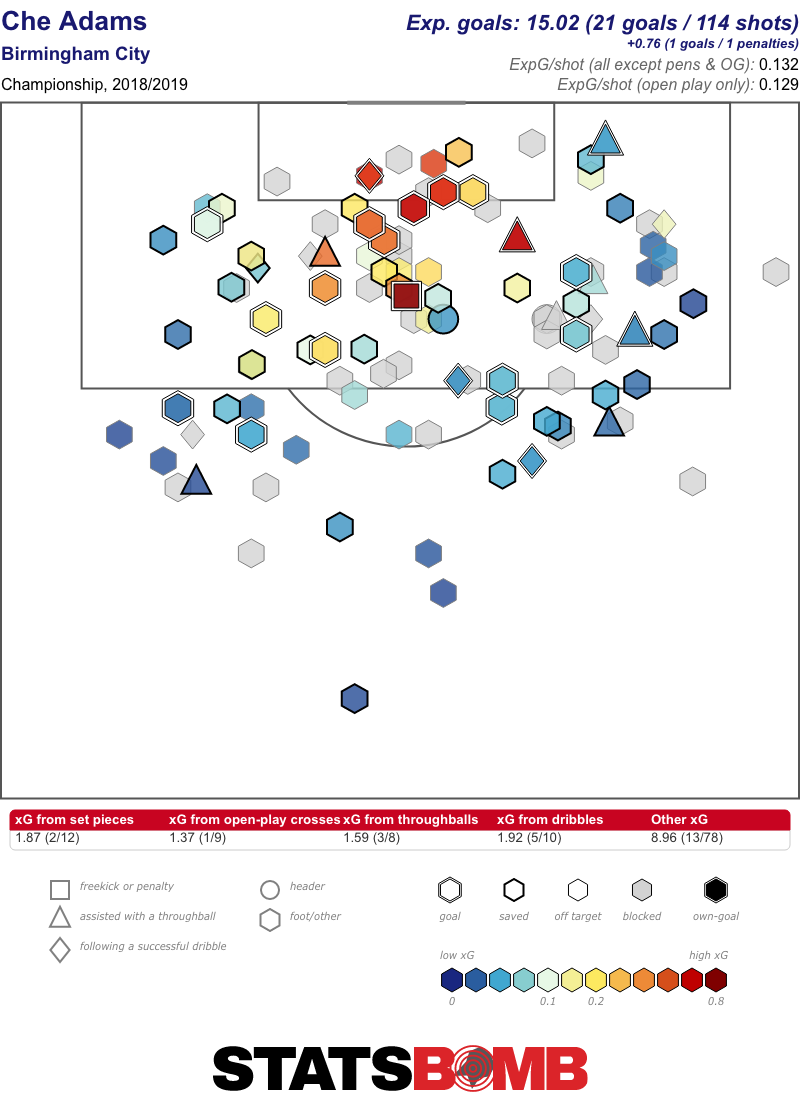 The 23-year-old outperformed his underlying numbers, and it was by far the most impressive campaign of his career to date. The fee was okay given the general price of young English talent, he does seem to have a knack for striking the ball unexpectedly quickly on the turn, and initial pre-season impressions have been positive. It is, though, difficult to see him having a transformative effect on the Southampton attack. Saints spent a million less on Standard Liege winger Moussa Djenepo on the back of eight goals and two assists last season. While much of his output was around league average for a player in his position in Belgium, there was one key area where he stood out: dribbling. He completed 3.19 dribbles per 90 and was also fouled a further 3.11 times per 90. Given that last season only four teams in the Premier League created fewer goals and less xG directly off of dribbles than Southampton -- both in an outright sense and as a percentage of their total goal and xG output -- a player of his profile was evidently required.
The 23-year-old outperformed his underlying numbers, and it was by far the most impressive campaign of his career to date. The fee was okay given the general price of young English talent, he does seem to have a knack for striking the ball unexpectedly quickly on the turn, and initial pre-season impressions have been positive. It is, though, difficult to see him having a transformative effect on the Southampton attack. Saints spent a million less on Standard Liege winger Moussa Djenepo on the back of eight goals and two assists last season. While much of his output was around league average for a player in his position in Belgium, there was one key area where he stood out: dribbling. He completed 3.19 dribbles per 90 and was also fouled a further 3.11 times per 90. Given that last season only four teams in the Premier League created fewer goals and less xG directly off of dribbles than Southampton -- both in an outright sense and as a percentage of their total goal and xG output -- a player of his profile was evidently required. 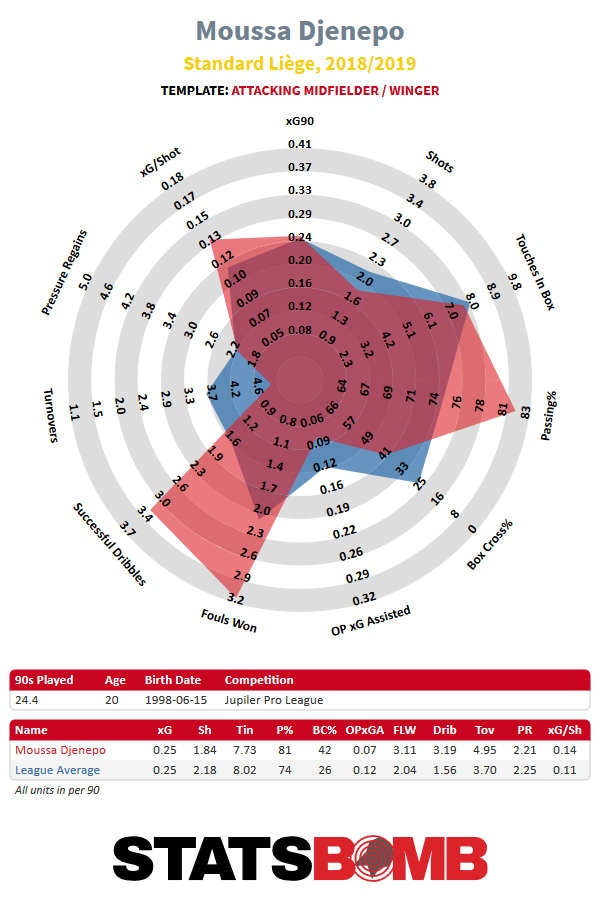 The 21-year-old joined preseason training a little later than most following his participation in the Africa Cup of Nations with Mali and it may, therefore, take him a bit longer to settle in. But if he can handle the step up in league quality, at a base attribute level he has the potential to make an impact. “He is an exciting player, with tremendous pace and good finishing abilities,” Hasenhüttl said upon his signing. “I think he will be an excellent fit for our style of play and shape.” Southampton are yet to bring in the creative passer they lacked last season (as Grace and Moe highlighted in their December piece on possible winter window targets), while a more athletic central defender also wouldn’t go amiss, but any further transfer work is likely to be put on hold until a bloated squad has been trimmed down to a more manageable size -- both financially and practically. Hasenhüttl is also keen to make space for academy products to come through into the first-team group. He gave debuts to four such players last season, and seems content to lean on the as of yet untested Jake Vokins as a back up to Ryan Bertrand at left-back. Hasenhüttl’s willingness to work with and mould young players was one of the things that made him an attraction option for a club seeking to return to the model that powered their ascent from League One to a position as a stable Premier League team. The permanent appointment of Hughes was the most obvious indicator of the degree to which Southampton had drifted away from that model and likely contributed to last season’s departure of long-standing sporting director Les Reed. Chairman Ralph Krueger and technical director Martin Hunter also parted ways with the club, clearing space for an ongoing institutional reshuffle. Southampton are clearly in the midst of a reboot but one that comes with limited risk. Even coming in midway through last season, Hasenhüttl was still able to get the defensive end of the team on the right course. If it continues that way, simply elevating the attack from bad to acceptable would likely result in a comfortable mid-table finish. That would represent an achievable first step towards a more profound long-term turnaround. Header image courtesy of the Press Association
The 21-year-old joined preseason training a little later than most following his participation in the Africa Cup of Nations with Mali and it may, therefore, take him a bit longer to settle in. But if he can handle the step up in league quality, at a base attribute level he has the potential to make an impact. “He is an exciting player, with tremendous pace and good finishing abilities,” Hasenhüttl said upon his signing. “I think he will be an excellent fit for our style of play and shape.” Southampton are yet to bring in the creative passer they lacked last season (as Grace and Moe highlighted in their December piece on possible winter window targets), while a more athletic central defender also wouldn’t go amiss, but any further transfer work is likely to be put on hold until a bloated squad has been trimmed down to a more manageable size -- both financially and practically. Hasenhüttl is also keen to make space for academy products to come through into the first-team group. He gave debuts to four such players last season, and seems content to lean on the as of yet untested Jake Vokins as a back up to Ryan Bertrand at left-back. Hasenhüttl’s willingness to work with and mould young players was one of the things that made him an attraction option for a club seeking to return to the model that powered their ascent from League One to a position as a stable Premier League team. The permanent appointment of Hughes was the most obvious indicator of the degree to which Southampton had drifted away from that model and likely contributed to last season’s departure of long-standing sporting director Les Reed. Chairman Ralph Krueger and technical director Martin Hunter also parted ways with the club, clearing space for an ongoing institutional reshuffle. Southampton are clearly in the midst of a reboot but one that comes with limited risk. Even coming in midway through last season, Hasenhüttl was still able to get the defensive end of the team on the right course. If it continues that way, simply elevating the attack from bad to acceptable would likely result in a comfortable mid-table finish. That would represent an achievable first step towards a more profound long-term turnaround. Header image courtesy of the Press Association
2019
Southampton: 2019-20 Season Preview
By admin
|
August 2, 2019
